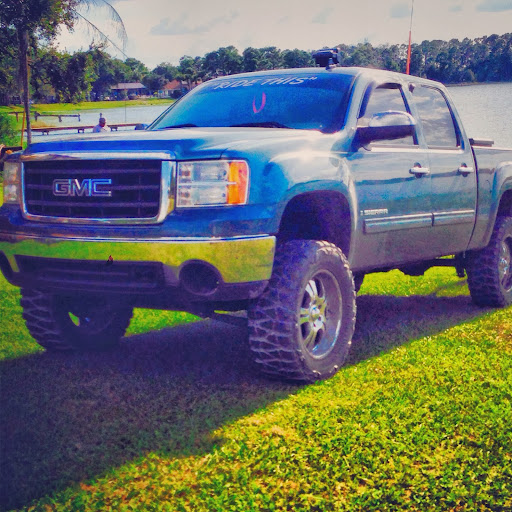Christopher J Coyle
age ~42
from Richland, WA
- Also known as:
-
- Christopher James Coyle
- Chris Coyle
- Chris J Cuyle
- Phone and address:
- 501 Delafield Ave, Richland, WA 99352
Christopher Coyle Phones & Addresses
- 501 Delafield Ave, Richland, WA 99352
- Seaside, OR
- Fort Meade, FL
- Warrenton, OR
- Nampa, ID
- Coeur d Alene, ID
- Kennewick, WA
- Redmond, OR
- Connell, WA
- Eltopia, WA
Resumes

Advisor
view sourceLocation:
Richland, WA
Industry:
Warehousing
Work:
Autozone Dc
Advisor
Toyota of Tri-Cities Feb 2017 - Mar 2017
Sales Associate
Lineage Logistics Aug 2009 - Jul 2016
Superintendent
Thomas Furniture Jul 2008 - Aug 2009
Sales Associate
Shopko Feb 2005 - Jul 2008
General Merchandise Manager
Advisor
Toyota of Tri-Cities Feb 2017 - Mar 2017
Sales Associate
Lineage Logistics Aug 2009 - Jul 2016
Superintendent
Thomas Furniture Jul 2008 - Aug 2009
Sales Associate
Shopko Feb 2005 - Jul 2008
General Merchandise Manager
Education:
Columbia Basin College 2001 - 2002
Skills:
Forklift Operation
Forklift Training
Supervisory Skills
Communication
Cpr and First Aid Certified
Rf Scanner Knowledge
Computer Skills
Third Party Logistics
Continuous Process Improvement
Quality Management
Workplace Safety
Retail Management
Freight Team Supervisory
Furniture Sales
Selling Cars
Forklift Training
Supervisory Skills
Communication
Cpr and First Aid Certified
Rf Scanner Knowledge
Computer Skills
Third Party Logistics
Continuous Process Improvement
Quality Management
Workplace Safety
Retail Management
Freight Team Supervisory
Furniture Sales
Selling Cars

General Consultant
view sourceWork:
General Consultant
Us Patents
-
Method For Producing High Purity Low Dielectric Constant Ceramic And Hybrid Ceramic Films
view source -
US Patent:8012403, Sep 6, 2011
-
Filed:Sep 14, 2001
-
Appl. No.:10/489924
-
Inventors:Jerome C. Birnbaum - Richland WA, US
Glen E. Fryxell - Kennewick WA, US
Shari Li Xiaohong - Richland WA, US
Christopher A. Coyle - Pasco WA, US
Glen C. Dunham - Kennewick WA, US
Suresh Baskaran - Kennewick WA, US
Ralph E. Williford - Kennewick WA, US -
Assignee:Battelle Memorial Institute - Richland WA
-
International Classification:B28B 1/30
-
US Classification:264656, 264 44, 264628, 264675
-
Abstract:Porous ceramic and hybrid ceramic films are useful as low dielectric constant interlayers in semiconductor interconnects. (Hybrid ceramic films are defined as films that contain organic and ceramic molecular components in the structure, as, for example, organosilicates). This invention describes the usefulness of humidity treatments (using specific temperature/humidity treatments as illustrative examples) in increasing mechanical integrity of porous dielectric films with minimal detrimental effect on film porosity or dielectric constant and with no adverse impact on film quality. The efficacy of such treatments is illustrated using surfactant-templated mesoporous silicate films as an example. This invention also describes a specific family of additives to be used with highly pure alkali-metal-free ceramic and hybrid precursors for such dielectric films that will enable better control of the film porosity and quality and lower dielectric constants with the required mechanical integrity. The efficacy of such additives is illustrated using surfactant-templated mesoporous silicate films as a model example.
-
Mesoporous Silica Film From A Solution Containing A Surfactant And Methods Of Making Same
view source -
US Patent:20020034626, Mar 21, 2002
-
Filed:Apr 18, 2001
-
Appl. No.:09/837885
-
Inventors:Jun Liu - West Richland WA, US
Karel Domansky - Cambridge MA, US
Xiaohong Li - Richland WA, US
Glen Fryxell - Kennewick WA, US
Suresh Baskaran - Kennewick WA, US
Nathan Kohler - Richland WA, US
Suntharampillai Thevuthasan - Kennewick WA, US
Christopher Coyle - Richland WA, US
Jerome Birnbaum - Richland WA, US -
International Classification:B32B003/26
-
US Classification:428/312600, 427/240000, 427/385500, 428/313500
-
Abstract:The present invention is a mesoporous silica film having a low dielectric constant and method of making having the steps of combining a surfactant in a silica precursor solution, spin-coating a film from this solution mixture, forming a partially hydroxylated mesoporous film, and dehydroxylating the hydroxylated film to obtain the mesoporous film. It is advantageous that the small polyoxyethylene ether surfactants used in spin-coated films as described in the present invention will result in fine pores smaller on average than about 20 nm. The resulting mesoporous film has a dielectric constant less than 3, which is stable in moist air with a specific humidity. The present invention provides a method for superior control of film thickness and thickness uniformity over a coated wafer, and films with low dielectric constant.
-
High Strength Insulating Metal-To-Ceramic Joints For Solid Oxide Fuel Cells And Other High Temperature Applications And Method Of Making
view source -
US Patent:20060060633, Mar 23, 2006
-
Filed:Sep 22, 2004
-
Appl. No.:10/948346
-
Inventors:K. Weil - Richland WA, US
Lawrence Chick - West Richland WA, US
Christopher Coyle - Pasco WA, US
John Hardy - Richland WA, US
Guanguang Xia - Pasco WA, US
Kerry Meinhardt - Kennewick WA, US
Vincent Sprenkle - Richland WA, US
Dean Paxton - Kennewick WA, US -
Assignee:Battelle Memorial Institute - Richland WA
-
International Classification:H01M 2/02
-
US Classification:228101000, 429034000
-
Abstract:A seal formed between a metal part and a second part that will remain gas tight in high temperature operating environments which experience frequent thermal cycling, which is particularly useful as an insulating joint in solid oxide fuel cells. A first metal part is attached to an reinforcing material. A glass forming material in the positioned in between the first metal part and the second part, and a seal is formed between the first metal part and the second part by heating the glass to a temperature suitable to melt the glass forming materials. The glass encapsulates and bonds at least a portion of the reinforcing material, thereby adding tremendous strength to the overall seal. A ceramic material may be added to the glass forming materials, to assist in forming an insulating barrier between the first metal part and the second part and to regulating the viscosity of the glass during the heating step.
-
High Strength Insulating Metal-To-Metal Joints For Solid Oxide Fuel Cells And Other High Temperature Applications And Method Of Making
view source -
US Patent:20060063057, Mar 23, 2006
-
Filed:Sep 22, 2004
-
Appl. No.:10/948359
-
Inventors:K. Weil - Richland WA, US
Lawrence Chick - West Richland WA, US
Christopher Coyle - Pasco WA, US
John Hardy - Richland WA, US
Guanguang Xia - Pasco WA, US
Kerry Meinhardt - Kennewick WA, US
Vincent Sprenkle - Richland WA, US
Dean Paxton - Kennewick WA, US -
Assignee:Battelle Memorial Institute - Richland WA
-
International Classification:H01M 2/02
-
US Classification:429034000, 228101000
-
Abstract:A seal formed between a metal part and a second part that will remain gas tight in high temperature operating environments which experience frequent thermal cycling, which is particularly useful as an insulating joint in solid oxide fuel cells. A first metal part is attached to a reinforcing material. A glass forming material in the positioned in between the first metal part and the second part, and a seal is formed between the first metal part and the second part by heating the glass to a temperature suitable to melt the glass forming materials. The glass encapsulates and bonds at least a portion of the reinforcing material, thereby adding tremendous strength to the overall seal. A ceramic material may be added to the glass forming materials, to assist in forming an insulating barrier between the first metal part and the second part and to regulating the viscosity of the glass during the heating step.
-
High Strength Insulating Metal-To-Ceramic Joints For Solid Oxide Fuel Cells And Other High Temperature Applications And Method Of Making
view source -
US Patent:20090130458, May 21, 2009
-
Filed:Jan 26, 2009
-
Appl. No.:12/359530
-
Inventors:K. Scott Weil - Richland WA, US
Lawrence A. Chick - West Richland WA, US
Christopher A. Coyle - Pasco WA, US
John S. Hardy - Richland WA, US
Guanguang Xia - Pasco WA, US
Kerry D. Meinhardt - Kennewick WA, US
Vincent L. Sprenkle - Richland WA, US
Dean M. Paxton - Kennewick WA, US -
International Classification:B32B 15/04
C03C 27/02 -
US Classification:428433, 65 591, 428332
-
Abstract:A seal formed between a metal part and a second part that will remain gas tight in high temperature operating environments which experience frequent thermal cycling, which is particularly useful as an insulating joint in solid oxide fuel cells. A first metal part is attached to a reinforcing material. A glass forming material in the positioned in between the first metal part and the second part, and a seal is formed between the first metal part and the second part by heating the glass to a temperature suitable to melt the glass forming materials. The glass encapsulates and bonds at least a portion of the reinforcing material, thereby adding tremendous strength to the overall seal. A ceramic material may be added to the glass forming materials, to assist in forming an insulating barrier between the first metal part and the second part and to regulating the viscosity of the glass during the heating step.
-
Intermediate Temperature Sodium Metal-Halide Energy Storage Devices
view source -
US Patent:20130196224, Aug 1, 2013
-
Filed:Jan 29, 2013
-
Appl. No.:13/752936
-
Inventors:Guosheng Li - Richland WA, US
Xiaochuan Lu - Richland WA, US
Vincent L. Sprenkle - Richland WA, US
John P. Lemmon - Kennewick WA, US
Zhenguo Yang - Bellevue WA, US
Christopher A. Coyle - Pasco WA, US -
Assignee:BATTELLE MEMORIAL INSTITUTE - Richland WA
-
International Classification:H01M 10/0563
-
US Classification:429199
-
Abstract:Sodium metal-halide energy storage devices utilizing a substituting salt in its secondary electrolyte can operate at temperatures lower than conventional ZEBRA batteries while maintaining desirable performance and lifetime characteristics. According to one example, a sodium metal-halide energy storage device operates at a temperature less than or equal to 200 C. and has a liquid secondary electrolyte having MNaAlClH, wherein M is a metal cation of a substituting salt, H is an anion of the substituting salt, y is a mole fraction of substituted Na and Cl, and x is a ratio of y over r, where r is the oxidation state of M. The melting temperature of the substituting salt is less than that of NaCl.
-
Mesoporous Silica Film From A Solution Containing A Surfactant And Methods Of Making Same
view source -
US Patent:63290170, Dec 11, 2001
-
Filed:Oct 4, 1999
-
Appl. No.:9/413062
-
Inventors:Jun Liu - West Richland WA
Karel Domansky - Cambridge MA
Xiaohong Li - Richland WA
Glen E. Fryxell - Kennewick WA
Suresh Baskaran - Kennewick WA
Nathan J. Kohler - Richland WA
Suntharampillai Thevuthasan - Kennewick WA
Christopher A. Coyle - Richland WA
Jerome C. Birnbaum - Richland WA -
Assignee:Battelle Memorial Institute - Richland WA
-
International Classification:B05D 312
-
US Classification:427240
-
Abstract:The present invention is a mesoporous silica film having a low dielectric constant and method of making having the steps of combining a surfactant in a silica precursor solution, spin-coating a film from this solution mixture, forming a partially hydroxylated mesoporous film, and dehydroxylating the hydroxylated film to obtain the mesoporous film. It is advantageous that the small polyoxyethylene ether surfactants used in spin-coated films as described in the present invention will result in fine pores smaller on average than about 20 nm. The resulting mesoporous film has a dielectric constant less than 3, which is stable in moist air with a specific humidity. The present invention provides a method for superior control of film thickness and thickness uniformity over a coated wafer, and films with low dielectric constant.
Isbn (Books And Publications)


Dragonlance: Key of Destiny Age of Mortals Campaign
view sourceAuthor
Christopher Coyle
ISBN #
1931567115
Lawyers & Attorneys

Christopher Coyle - Lawyer
view sourceOffice:
Greenberg Traurig, LLP
Phone:
4402033498 (Phone)
Specialties:
Real Estate Funds
Corporate
Financial Regulatory & Compliance
Corporate
Financial Regulatory & Compliance
ISLN:
1000003250
Admitted:
2014
University:
BPP University, Legal Practice Course, 2015
Law School:
University of Manchester, LL.B., 2014
Links:
Site

Christopher Coyle - Lawyer
view sourceOffice:
Henry & Beaver LLP
Specialties:
Plaintiff's Personal Injury
General Civil Litigation, including Commercial, Construction, and Collections
Criminal Defense
Employment Law
General Civil Litigation, including Commercial, Construction, and Collections
Criminal Defense
Employment Law
ISLN:
908144639
Admitted:
1979
University:
Pennsylvania State University, B.A., 1976
Law School:
University of Pittsburgh School of Law, J.D., 1979

Christopher Coyle - Lawyer
view sourceOffice:
Sussman Shank LLP
Specialties:
Chapter 13 Bankruptcy
Chapter 11 Bankruptcy
Chapter 7 Bankruptcy
Bankruptcy
Tax Law
Chapter 11 Bankruptcy
Chapter 7 Bankruptcy
Bankruptcy
Tax Law
ISLN:
921988143
Admitted:
2007
University:
University of South Carolina, B.A., 2004
Law School:
Lewis & Clark Law School, J.D., 2007
Googleplus

Christopher Coyle
Education:
Wheaton College - History/ Biblical & Theological Studies

Christopher Coyle

Christopher Coyle

Christopher Coyle

Christopher Coyle

Christopher Coyle

Christopher Coyle

Christopher “Hiker69” Coyle
Plaxo

Christopher Coyle
view sourceYoutube
Classmates

Christopher Coyle
view sourceSchools:
Seton Catholic High School Pittston PA 1989-1993
Community:
Lynn Martinez, Robert Phillips, Patricia Ardoline

Christopher Coyle (Callow...
view sourceSchools:
Williams High School Williams CA 1994-1998
Community:
Rhonda Riggs, Vickie Foster, Diana Knight

Christopher Coyle
view sourceSchools:
Eustis High School Eustis FL 2001-2005
Community:
Christa Ogle

Christopher Coyle
view sourceSchools:
Holy Cross High School Dover DE 1982-1986
Community:
Ed Palenski, Lisa Hawkins, David O'brien

Chris Coyle | James W. Ma...
view source
Chris Coyle | Farmingdale...
view source
Chris Coyle | Seton Hall ...
view source
Chris Coyle, Linden High ...
view source
Christopher Coyle Sr.
view source
Christopher Coyle
view source
Christopher Ryan Coyle
view source
Christopher Coyle
view source
Christopher RideThis Coyle
view source
Chelsea Christopher Coyle
view source
Christopher L Coyle
view source
Christopher M Coyle
view sourceFlickr
Myspace
Get Report for Christopher J Coyle from Richland, WA, age ~42




![[can talk with Chris] [can talk with Chris]](https://i.ytimg.com/vi/8NMsJZPEt_o/hq720_2.jpg?sqp=-oaymwE2CNAFEJQDSFTyq4qpAygIARUAAIhCGABwAcABBvABAfgBvgSAAoAKigIMCAAQARhlIGEoWzAP&rs=AOn4CLC3TVvz5kyQDTkOuGm6JBh9bRoJqw)












